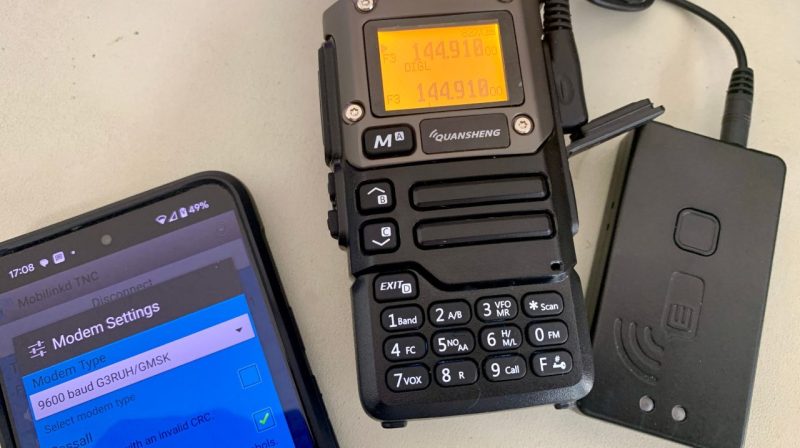Have you ever thought about getting into digital modes on the ham bands? As it turns out, you can get involved using the affordable and popular Quansheng UV-K6 — if you’re game to modify it, that is. It’s perfectly achievable using the custom Mobilinkd firmware, the brainchild of one [Rob Riggs].
In order to efficiently transmit digital modes, it’s necessary to make some hardware changes as well. Low frequencies must be allowed to pass in through the MIC input, and to pass out through the audio output. These are normally filtered out for efficient transmission of speech, but these filters mess up digital transmissions something fierce. This is achieved by messing about with some capacitors and bodge wires. Then, one can flash the firmware using a programming cable.
With the mods achieved, the UV-K6 can be used for transmitting in various digital modes, like M17 4-FSK. The firmware has several benefits, not least of which is cutting turnaround time. This is the time the radio takes to switch between transmitting and receiving, and slashing it is a big boost for achieving efficient digital communication. While the stock firmware has an excruciating slow turnaround of 378 ms, the Mobilinkd firmware takes just 79 ms.
Further gains may be possible in future, too. Bypassing the audio amplifier could be particularly fruitful, as it’s largely in the way of the digital signal stream.
Quansheng’s radios are popular targets for modification, and are well documented at this point.
















Is it possible to do hardware mod on it to get more memory/flash for code and then get firmware with all fancy functionality?
You can replace the EEPROM chip with a bigger one and then load firmwares from there almost on the fly.
See https://github.com/losehu/uv-k5-bootloader-custom/blob/main/README_en.md .
“Have you ever thought about getting into digital modes on the ham bands? As it turns out, you can get involved using the affordable and popular Quansheng UV-K6 — if you’re game to modify it, that is.”
Not with my Quansheng UV-K6. The spurious emissions outside the 70cm band always exceed the -40 dBc FCC limit for an amateur transmitter. I can add a Mini-Circuits lumped element low-pass filter (LPF) to fix the problem, but the filter costs more than the radio. I designed a 7th-order elliptical (Cauer) LPF [1], but the component values were too difficult to achieve by simple means. The bottom line is the Quansheng UV-K6 is a piece of garbage as a transmitter – at least mine is. Don’t transmit with one unless you check the spectral purity first with a spectrum analyzer you trust.
1. Elliptic Filter
https://en.wikipedia.org/wiki/Elliptic_filter
Everyone of the “low cost”(trash) radios I have tested
are NOT legal. As stated above- poor/no filtering.
Mobilinkd? I once built an software TNC using an DIY Arduino and the Mobilinkd firmware! It even worked (more or less)! 😃
Can You create a reticulum.network and arduino?
I search one.
“Have you ever thought about getting into digital modes on the ham bands?”
Yes and no.
I like the idea to have an CAT interface for remote controlled frequency input being implemented (sat tracker software for doppler correction).
That way, decoding SSTV from ISS would be more stable. The picture wouldn’t tilt so much. Frequency stability is important here, even though some SSTV equipment can compensate a bit.
And an FSK port would be nice, too, so I could do proper APRS/Packet Radio using FSK rather than AFSK.
Most higher end UHF/VHF base stations of the 1980s/1990s had this. It made high-speed RTTY/AMTOR and 9k6 Packet-Radio possible.
On the reception side, tapping the FM discriminator pin of a cheap FM scanner would be sufficient, as well.
If the Quangshen has one, it could be modified similarly.
(FSK is nicer because of solving the issue with the wrong tone channel being louder than the other a bit;
the AF stage might be causing some trouble sometimes.
Ok, it’s not *that* bad, in practice, but if FSK is available it’s being preferred).
On the other hand, I wouldn’t dare to make a connection to ISS with such a radio here.
I have way too much respect for ISS to try that. I should use my best, cleanest transmitter here. It’s also a matter of dignity to me.
I see, the firmware implements FSK directly in software. Makes me wonder how good the decoding algorithm is. It’s worse than using DireWolf on PC, I assume.
Hm. How clean is the signal here? Is it creating a smoothed signal or an unfiltered square wave signal?
Like an unfiltered TTL speaker output of an 1980s IBM PC?
Because, radio signals in the air should be always be sine-like, even if it’s a digital signal.
Very please make an interface to the reticulum.network . Not everyone has licenses and in an emergency there will be a laptop. All you need is a micUSB cable.
On PMR bands it would be very helpful.
Would really love to see someone tx/rx M17 with this radio.
meshtastic? :)
Is it possible to xmit an IQ stream on the Quansheng? Like a poor man’s HackRF? I want to use it as the output for Spectrum Paint.